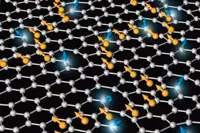 A team of researchers from three US universities has demonstrated a way to vary the number of electrons in a give region of a piece of graphene. The team says this is a proof of principle in the creation of semiconductor devices using the so called 'wonder material'. It adds that the number of electrons can be tuned through the application of an electric field and says this could enable future devices to be 'rewired' dynamically.
A team of researchers from three US universities has demonstrated a way to vary the number of electrons in a give region of a piece of graphene. The team says this is a proof of principle in the creation of semiconductor devices using the so called 'wonder material'. It adds that the number of electrons can be tuned through the application of an electric field and says this could enable future devices to be 'rewired' dynamically.
The research has been conducted at the University of Pennsylvania, the University of California, Berkeley and the University of Illinois at Urbana-Champaign.
"We've come up with a non destructive, reversible way of doping that doesn't involve any physical changes to the graphene," said Andrew Rappe from the University of Pennsylvania.
The technique involves depositing a layer of graphene so it rests on, but doesn't bond to, a layer of lithium niobate. Lithium niobate is ferroelectric, meaning that it is polar, and its surfaces have either a positive or negative charge. Applying an electric field pulse can change the sign of the surface charges.
The researchers took advantage of the fact that a certain type of the material, periodically poled lithium niobate, is manufactured so that it has 'stripes' of polar regions that alternate between positive and negative.
"Because the lithium niobate domains can dictate the properties," said Moonsub Shim from the University of Illinois, "different regions of graphene can take on different character, depending on the nature of the domain underneath. That allows a simple means of creating a p-n junction or even an array of p-n junctions on a single flake of graphene. Such an ability should facilitate advances in graphene that might be analogous to what p-n junctions and complementary circuitry has done for the current state-of-the-art semiconductor electronics."
Because the oxide polarisation can be altered, the type and extent of supported graphene doping can also be altered. Lane Martin from UC Berkeley said: "You write an 'up' domain or a 'down' domain in the region you want and the graphene's charge density would reflect that change. You could make the graphene over that region p-type or n-type, and, if you change your mind, you can erase it and start again."
This is said to represent an advantage over chemically doped semiconductors because once atomic impurities are added, they can't be removed. Future research will investigate the feasibility of designing dynamic semiconducting devices with this technique.
Author
Graham Pitcher
Source: www.newelectronics.co.uk

